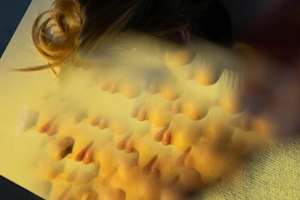
Photo by DANIEL FARÒ
What’s The Difference Between Natural Vs. Synthetic Psychedelics?
Are Mother Nature’s wonders all that different from lab creations? Let’s find out.
Today, we journey through the psychedelic spectrum.
From the ancient roots of natural psychedelics to the cutting-edge labs crafting their synthetic cousins, this exploration delves into their unique worlds. We’ll unravel the effects of psychedelic substances on our minds, the cultural tales they tell, and the fine line between their therapeutic uses and risks.
Whether you’re a psychedelic connoisseur or just psychedelic-curious, join us on this informative trip to understand what sets these natural and synthetic wonders apart.

Natural Psychedelics
Natural psychedelics stand apart in a world where ‘natural’ is often a marketing gimmick. These include substances like psilocybin from magic mushrooms, mescaline from cacti, and DMT from ayahuasca.
Unlike their synthetic counterparts created in labs, these substances are the real deal from Mother Nature, naturally occurring in plants or fungi.
History and Culture
Rooted in millennia-old traditions, natural psychedelics have shaped spiritual and healing practices worldwide. These substances trace back to ancient civilizations, carving their stories into the fabric of diverse cultures.
In Central and South America, psilocybin mushrooms were not just a part of rituals; they were sacred tools for connecting with the divine, playing a prominent role in Aztec and Maya civilizations. Similarly, indigenous groups in North America revered the peyote cactus for the deep spiritual journey it leads users on, usually providing profound insights, healing, and connection with divine entities.
Contemporary times have seen a significant integration of natural psychedelic substances into medicinal contexts. Clinical trials have increasingly explored the potential of substances like DMT and psilocybin in alleviating symptoms of depression, anxiety, and PTSD.
Common Uses And Effects
Natural psychedelics like psilocybin, mescaline, and DMT are psychoactive substances commonly used for spiritual enlightenment and therapeutic purposes.
These substances typically induce profound changes in consciousness, providing users with intense visual and auditory sensations, altered perception of space and time, and deep introspective experiences.
Often, these experiences lead to a greater sense of connectedness, emotional understanding, and, in some cases, long-lasting positive changes in perspective and mental health.

Synthetic Psychedelics
Synthetic psychedelics are those created in controlled settings like a laboratory, bringing science and precision into the mix.
Unlike their natural counterparts, synthetic psychedelic substances, such as LSD, MDMA, and ketamine, are the products of chemical synthesis, offering a different kind of psychedelic journey.
Their creation often aims to replicate or modify the effects of natural psychedelics or explore new realms of the psychedelic experience entirely.
History and Culture
The history and culture of synthetic psychedelics is more recent than that of natural ones. LSD, for instance, was discovered in 1938 by Albert Hofmann, a Swiss chemist.
Its grand impact on consciousness quickly catapulted it into the spotlight during the 1950s and 1960s, becoming a counterculture and social revolution symbol.
MDMA, developed in the early 20th century, gained popularity in the 1980s club scene, embodying a culture of communal bonding. Synthetic psychedelics, unlike natural ones, don’t have deep-seated routes in ancient rituals but have created their unique cultural footprint, influencing music, art, and social movements.
Common Uses and Effects
Synthetic psychedelics are known mainly for their potent psychoactive effects. LSD, for example, is renowned for its strong visual hallucinations and deep introspective journeys.
MDMA, often associated with heightened empathy and euphoria, is used to commonly enhance social connectivity by its users. Ketamine, initially an anesthetic, offers a dissociative experience, leading to shifts in perception and consciousness.
Clinically, these substances are being explored for therapeutic uses, such as MDMA for PTSD treatment and ketamine for depression. Their effects can be intense and last long, underscoring the importance of controlled and mindful usage.

Risks And Rewards
Both natural and synthetic psychedelics come with their own set of risks and rewards.
On the risk side, they can intensify or trigger psychosis, particularly in those with underlying mental health conditions. Users may also experience hallucinations, paranoia, and physical side effects like dizziness.
Synthetic substances, such as LSD and MDMA, can additionally cause memory loss and erratic behavior, potentially affecting long-term social and economic stability. However, the rewards, especially in controlled therapeutic settings, are significant.
Both types can offer relief from mental health disorders, deep psychological insights, and enhanced self-awareness. Mindful usage, considering the user’s mindset and environment, is crucial to maximize their therapeutic potential while minimizing risks like psychosis.

Similarities And Differences
While natural and synthetic psychedelics differ in origin, they share similarities in their ability to alter consciousness and perception profoundly. Both interact with the brain’s serotonin receptors and can lead to similar therapeutic outcomes, such as relief from mental health conditions.
The main difference lies in their composition and consistency: natural psychedelics are derived from plants or fungi, with varying potencies, while synthetics are lab-created, offering more controlled dosages.
Additionally, the cultural and historical contexts of natural psychedelics are richer, often tied to ancient rituals and healing practices, as opposed to the more recent clinical development of synthetic psychedelics.
Ultimately, whether they’re gifts from nature or marvels of science, these powerful substances command respect and caution, opening doors to the intricate terrains of the mind and soul – realms that demand careful navigation.
Herb Recommended Products:
READ MORE










